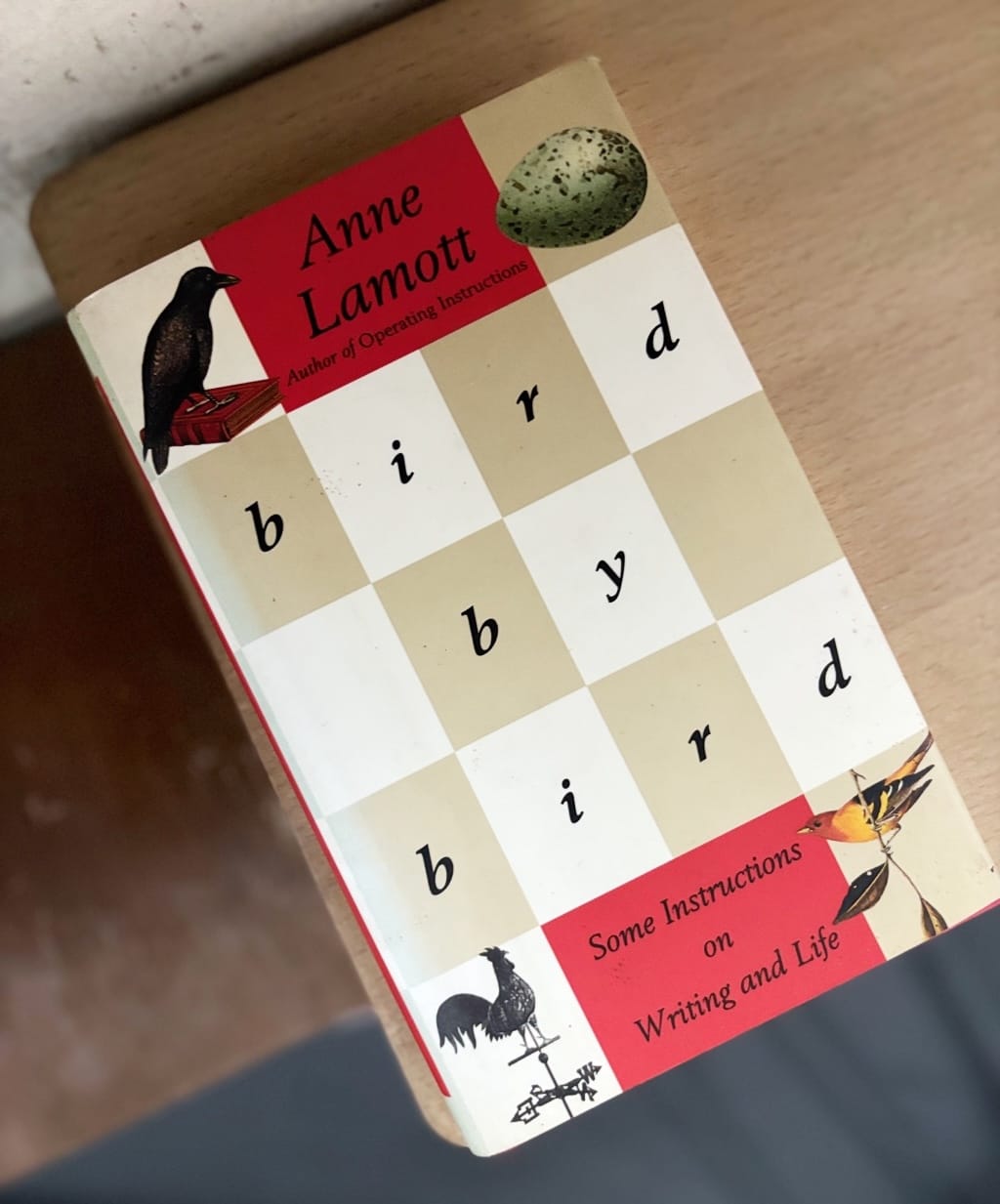Anne Lamott’s Bird by Bird (1994) has earned its place as a classic in the world of creative nonfiction, offering writers a compassionate, honest, and humorous guide to navigating the craft. Through Lamott’s poignant reflections, witty anecdotes, and refreshing vulnerability, she presents a core theme that resonates with writers and readers alike: the beauty of taking things one step at a time.
Lamott begins by sharing insights from her own experiences, illustrating challenges and triumphs familiar to anyone who has faced a blank page. Her stories are imbued with a warmth that makes them both engaging and instructive. By normalizing the hurdles writers encounter, she eases the pressure of perfectionism, inviting them to take small, manageable steps—like crafting a piece “bird by bird.”
But Bird by Bird is more than just a book about writing techniques; it’s a meditation on the creative process itself, encouraging readers to embrace patience, honesty, and humor. She encourages aspiring writers to approach their work with patience while embracing each stage of the process without fear of imperfection. Lamott’s approach offers both new and seasoned writers a unique blend of inspiration and practical guidance.
Core Metaphor and Themes
The enduring appeal of Bird by Bird lies in its ability to connect with writers on a personal level. The book offers a sincere and human take on the writing journey, making it a staple for many. Through candid tales and wise advice, Lamott taps into universal truths about perseverance and creativity, making her book a beloved guide for those navigating the complexities of writing.
In exploring Bird by Bird from a literary perspective, we can see how Lamott’s central metaphor, her unique character portrayals, and her reflections on imperfection transform the book into a celebration of the creative journey. It’s a guide to self-discovery that speaks to anyone navigating a path of growth, exploration, and expression.
The Essence of One Step at a Time
At the heart of Bird by Bird lies the powerful metaphor that gives the book its title. Facing the daunting task of writing a report on birds, Lamott’s brother was overwhelmed by the sheer volume of information. Their father’s advice? “Bird by bird, buddy. Just take it bird by bird.” This simple yet profound wisdom becomes a guiding principle throughout the book, reminding us to break down overwhelming tasks into manageable steps.
This approach encourages writers to cultivate patience by focusing on each task individually. Tackling challenges step-by-step helps lessen the overwhelming nature of creative work, making large projects feel more manageable. Through her personal anecdotes, Lamott brings her metaphor to life, reminding readers that whether they’re wrestling with a writing project or navigating the complexities of life, progress comes from embracing the small, immediate steps—what she calls the “one-inch picture frame”—and letting go of the need to see the whole picture all at once.
Shitty First Drafts and the Freedom to Experiment
Lamott’s concept of “shitty first drafts” is essential in freeing writers from the burden of perfection. She suggests that embracing an imperfect first draft creates space for creativity to flow without the weight of self-criticism. This approach breaks down the fear of failure and the pressure to get everything right on the first try, encouraging writers to approach their work with more openness and freedom.
The shitty first drafts philosophy aligns seamlessly with Lamott’s teachings on patience and acceptance, encouraging writers to see drafts as flexible stages rather than finished products. This approach fosters creativity through trial and revision, empowering writers to confront and quiet their inner critic. By embracing this process, writers create a more open environment for creative exploration and growth.
Voices Within the Writer’s Mind
Lamott introduces various “characters” such as the inner critic and the perfectionist, personifying the challenges faced by writers. These characters give voice to the insecurities and doubts that often accompany the creative process, making them tangible. By personifying these inner voices, Lamott creates a relatable narrative that draws readers into the emotional journey of creativity. These characters serve as reminders of the doubts, fears, and anxieties that accompany the creative process and the ways we must overcome them.
Through this approach, readers can identify with these internal voices, realizing they are not alone in their struggles, as Lamott connects the reader to her own experiences of battling self-doubt and criticism. Each anecdote serves as a window into her mindset, showcasing moments of self-reflection and realization. Through these glimpses, she illustrates how confronting these internal voices is part of the growth and development in the writing process.
These stories in the book offer a narrative that many writers may recognize in their own journeys, instilling a sense of comfort and trust. Lamott’s conversational tone is key to creating an intimate connection with the reader. Her approachable writing style breaks down complex ideas, making them not only more relatable but also engaging.
Writing as a Tool for Self-Discovery

For Lamott, writing serves as a powerful means of self-discovery, a way to uncover one’s inner truths and bring them to light. Throughout Bird by Bird, she encourages readers to engage with writing as an act of self-revelation, allowing their authentic voices to emerge on the page without fear. She views writing as a mirror, offering us a clearer view of who we are and the courage to embrace it.
Lamott redefines writing as a process of truth-telling, where the focus moves away from external outcomes and towards the real value of writing itself, which lies in the insights it reveals about ourselves. In her view, writing is not simply a task to complete but a way to confront personal truths, creating a space for growth and reflection. This perspective shifts the reward from recognition to the internal satisfaction of self-discovery, making the act of writing itself a form of creative fulfillment.
By framing writing as an act of truth-telling, Lamott shifts the focus from writing as a means to an end (like publication or recognition) to writing as a means of personal exploration and understanding. Her insights encourage readers to embrace the act of writing for its own sake, to find meaning in the journey rather than the destination.
Developing a Writer’s Mindset
Lamott encourages writers to go beyond technical skills, advocating for introspection as a path to discovering personal truths and fostering emotional clarity. She suggests that writing serves not only as a tool for self-exploration but also as a way to understand others, with empathy being central to a writer’s mindset. By confronting one’s own vulnerabilities, writers can produce work that feels genuine and resonates on a deeper level with readers.
Central to Lamott’s approach is honesty—she encourages writers to delve into their most authentic feelings and share them freely. She promotes a creative process that transcends accomplishments, urging writers to view storytelling as an opportunity for real connection. This approach lends a truthful quality to narratives, turning self-expression into both a personal exploration and a bridge to others.
Embracing Imperfection in Writing and Life

Lamott’s reflections on imperfection acknowledge the shared struggles of writers, from self-doubt to writer’s block. Embracing flaws—both on the page and in life—frees writers from the relentless pursuit of perfection. Her “bird by bird” metaphor illustrates the value of taking large tasks in small, manageable steps, making creative work feel less overwhelming and more attainable.
She also emphasizes the importance of closely observing everyday life, a skill that grounds writers in reality and enriches their storytelling with authenticity. By showcasing her humor and vulnerability, Lamott offers a relatable narrative that reassures writers through their fears of judgment or failure. This approach helps writers embrace flaws, transforming obstacles into opportunities for authentic creation.
Why Bird by Bird Resonates with Readers Today
The timeless appeal of Bird by Bird lies in its universality. Lamott’s wisdom speaks to writers and readers alike, offering insights that go beyond the page and touch on broader themes of resilience, honesty, and patience. Her reflections on the creative process remind us that the act of creation—whether through writing, art, or any other pursuit—is an exercise in perseverance, a journey that requires us to face our fears and keep moving forward.
For readers and writers, Bird by Bird provides more than advice on writing; it offers a glimpse into the writer’s mind and heart. Lamott’s words resonate with anyone who has ever struggled to create something meaningful, offering solace, encouragement, and a gentle push to keep going. Her book is a testament to the power of stories to connect us, to help us understand ourselves and others, and to remind us that, ultimately, the creative journey is something we take one step at a time.
Selected Passage with Analysis
If something inside you is real, we will probably find it interesting, and it will probably be universal. So you must risk placing real emotion at the center of your work. Write straight into the emotional center of things. Write toward vulnerability. Don’t worry about appearing sentimental. Worry about being unavailable; worry about being absent or fraudulent. Risk being unliked. Tell the truth as you understand it. If you’re a writer, you have a moral obligation to do this. And it is a revolutionary act—truth is always subversive.
Page 226, Bird by Bird by Anne Lamott
In this passage, Anne Lamott emphasizes that good writing comes from embracing real emotion and vulnerability. She encourages writers to place true feelings at the center of their work, arguing that authenticity resonates more deeply with readers. By advising writers to "write straight into the emotional center of things," Lamott stresses the importance of expressing vulnerability rather than crafting a detached narrative.
The passage also underscores the revolutionary power of truth in writing, asserting that truth is "always subversive." Lamott suggests that writers have a moral obligation to tell the truth, even when it risks alienating or unsettling readers. This commitment to truth is not merely an ethical choice but a creative act that challenges the status quo and conventional boundaries of acceptable expression.
For writers, these ideas are crucial for producing work that feels genuine and impactful. By risking vulnerability and embracing emotional honesty, writers create stories that forge deep connections with their audience. Lamott’s insistence on truth as subversive highlights the transformative potential of writing that dares to expose raw human experiences.
Adhering to this advice can lead to work that is not only deeply personal but universally relatable, fostering a meaningful bond between writer and reader.
Further Reading
Anne Lamott on Writing and Why Perfectionism Kills Creativity by Maria Popova, The Marginalian
While There Are Still Writers: Reading Anne Lamott’s Bird By Bird by Tristan Foster, Medium
1994 Anne Lamott “Bird by Bird” at the San Francisco Public Library by San Francisco Public Library, YouTube
Am I the only person who doesn’t like Bird by Bird? on Reddit




